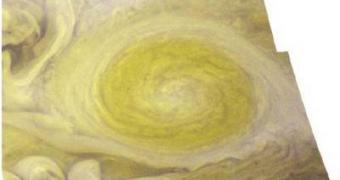The solar system's youngest storm, the Little Red Spot on Jupiter, has the highest wind speeds ever detected on any other planet, according to a team of researchers conducting observations with NASA' New Horizon spacecraft, the Hubble Space Telescope and the European Southern Observatory's Very Large Telescope. The New Horizon probe made a fly-by through the vicinity of Jupiter just last year in February, and captured this high resolution image of the Little Red Spot. The image is in fact a quasi-true-color composite generated using New Horizon's red and green channels and Hubble's 410 nanometer blue channel.
The Little Red Spot formed in the year 2000 after the merging of three smaller white storms, which have been observed on Jupiter ever since the 1930s. Two of the storms merged in 1998, followed in 2000 by the third one. Five years later the massive storm suddenly turned red, becoming the Little Red Spot we see today. It is an anticyclone, while the Great Red Spot is a cyclone, meaning it is rotating clockwise.
Previous observations conducted by NASA's Voyager and Galileo missions combined with New Horizon's Long Range Reconnaissance Imager reveal that the wind speeds of the Little Red Spot have substantially increased as compared to its precursors. New Horizon flew at a distance of about 2.4 million kilometers from Jupiter during its 2007 fly-by and was capable of creating an image with a resolution of 14.4 kilometers per pixel. It revealed that the maximum speed inside the Little Red Spot exceeded 614.4 kilometers per hour, way faster than any storm on Earth.
"This storm is still developing, and some of the changes remain mysterious. This unique set of observations is giving us hints about the storm's structure and makeup; from this, we expect to learn much more about how these large atmospheric disturbances form on worlds across the solar system", says Dr. Andrew Cheng of the Johns Hopkins University Applied Physics Laboratory.
Alternatively, its bigger sister, the Great Red Spot, which has been raging across Jupiter for more than three centuries, seems to be decreasing, while the whole atmosphere is passing through an increased turbulent state. The South Equatorial Belt for example, has ceased all activity, spawning a south tropical storm just north of the Little Red Spot.
"This was a rare opportunity to combine observations from a powerful suite of instruments, as Jupiter will not be visited again by a spacecraft until 2016 at the earliest", says Cheng.
Observations in the visible and mid-infrared spectrum with the Hubble and the Very Large Telescope combined with the map of the Long Range Reconnaissance Imager revealed the thermal structure and dynamics in the cloud layers beneath the visible ones, since infrared wavelengths can penetrate the upper layers of the Jovian atmosphere.
"The new observations confirm that the thermal structures, wind speeds, and cloud features of the LRS are very similar to those of the GRS. Both the LRS and the GRS extend into the stratosphere, to far higher altitudes than for the smaller storms on Jupiter", says Dr. Hal Weaver from APL, New Horizon project scientist.
The new observations are critical in understanding how and why the Little Red Spot turned red. It is most likely consistent with the increase in wind speed, which would also explain the color of the Great Red Spot.
"This supports the idea that a common dynamical mechanism explains the reddening of the two largest anticyclonic systems on Jupiter, one possibility of which is that storm winds dredge up material from below", says Dr. Amy Simon-Miller of NASA's Goddard Space Flight Center.
Scientists are now trying to predict what would happen next, since the Little Red Spot is picking up speed, and the Great Red Spot is suffering a decrease in both wind speed and size. The new observations suggest a probable interaction between the south tropical disturbance, the Little Red Spot, and the cyclonic region just south of the Little Red Spot. If their guess is correct, then the Great Red Spot will soon be dwarfed by its little sister.
"The Great Red Spot may not always be the largest and strongest storm on Jupiter. Continued monitoring of Jupiter's constantly evolving atmosphere will surely yield more surprises", says Dr. Glenn Orton of NASA's Jet Propulsion Laboratory.

 14 DAY TRIAL //
14 DAY TRIAL //